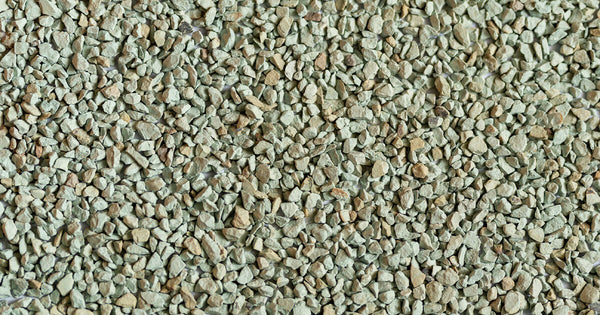Zeolite Filter Media Guide: What It Is and How It Is Used
Sep 15, 2021
Across a wide variety of industries, filtration is an essential component of the production and purification process. Through a variety of separation processes, liquids and gases can be filtered as they pass through a porous substance filtering larger particles.
The level of filtration and sanitation of a substance depends on the pore sizes of the filter media. Smaller pores means better filtration and particle separation under high flow filtration. Pore sizes can go down to 0.01 micrometers, small enough to prevent the passage of viruses.
In the cannabis industry, a variety of filtration media are used to remove contaminants such as pesticides, pigments, lipids, and waxes from cannabis concentrates. In this zeolite filter media guide, we will explore the nature of filtration and the pros and cons of zeolite cannabis post-processing.
What Is Natural Zeolite?
In nature, zeolite forms when volcanic rock or ash interacts with alkaline waters. The reaction can create a crystalline and microporous structure made of aluminosilicates such as aluminum, silica, and oxygen.
In a variety of applications, natural zeolite can be used to adsorb moisture and other molecules. In the cannabis industry, zeolite can adsorb pigments such as chlorophyll to clarify cannabis concentrates.
Natural zeolites come in about 40 different forms. Each of these forms has a unique composition that affects the way it adsorbs molecules. The most common type of zeolite is clinoptilolite.
Generally, zeolites are very good at cationic exchange, removing dissolved ions from a solution and replacing them with other ions that have a similar electric charge. Essentially, it can replace unwanted compounds in the solution.
Due to its natural filtration abilities, zeolite is used in a variety of applications such as agriculture, water purification, filtration, animal nutrition, and human health. Zeolites are capable of incorporating cations such as mercury, nickel, arsenic, and cadmium heavy metals and releasing phosphates, magnesium, or calcium.
Cation exchange properties vary by type of zeolite. Cation exchange is generally weaker in naturally-occurring zeolite than synthetic zeolites due to its potential impurities. Synthetically-derived zeolites are made with a heated solution of silica, aluminum, and sodium hydroxide.
How Is Zeolite Used?
Natural and synthetic zeolite media is used in a wide range of industrial applications due to its numerous benefits including:
-
High porosity
-
High surface area
-
Microcrystalline structure
-
Abrasion resistant
In various industries, media filters can be purchased or made at home. Operators may use one particular filtration media or several different media (multimedia filters) at the same time for more efficient filtration.
Filtration media can be layered using materials of different densities and sizes. Generally, the materials are layered from fine to coarse media. As the liquid passes through, the pores and gaps in between the media capture the particles that are too big to make it through.
Essentially, the top layers can capture the particles while the bottom layers provide support and proper drainage.
In other methods, the media are arranged from large to small gradients to allow for a gradual capturing of particles as the solution passes through.
Zeolites, in particular, are excellent filtration media due to their high porosity, which is generally a good marker of a high-performing media. Due to their high porosity, zeolite medias can capture compounds between grains and also adsorb them in the pores.
Since zeolite has a high porosity, it also has a large surface area that can separate high concentrations of undesirables before it needs back washing,which is the reversing of the flow of water from bottom to top.
One of the most beneficial aspects of zeolite filtration media is that it does not easily clog, which is especially helpful with high-flow extraction systems.
Natural and Synthetic Formations

Zeolites can form naturally through chemical reactions between saline water and volcanic glass at temperatures ranging from 80ºF and 131ºF (27ºC to 55ºC) and pH levels between 9 and 10. It can take anywhere from 50 to 50,000 years to finish the natural chemical reaction.
Naturally-occurring zeolites are not commonly phase-pure and include a varying degree of impurities of certain minerals. Due to this impurity, naturally-occurring zeolites are not commonly used in certain commercial applications where purity and uniformity is critical.
Synthetic zeolites offer a few advantages to naturally-occurring zeolites. Synthetic zeolites can be made in a uniform, phase-pure form. Synthetic zeolites are made using silica and alumina, two of the most abundant mineral components on earth. Zeolite production can be completed at a relatively lightning-fast speed compared to its natural production.
More than 150 zeolites have been synthetically created. The most common synthetic zeolites include the following zeolites:
-
A
-
X
-
Y
-
ZMS-5
Zeolite Applications
While this filter media has reached the cannabis market with great acclaim, natural zeolite has been used in a variety of applications that require a natural and ecological filtration method. Here are a few of the most common zeolite applications.
Agriculture
Zeolite can be used to improve the soil for agricultural purposes. In the soil, it can hold onto water and nutrients when rain or watered and gradually release as a slow-release fertilizer. It is used to improve soil acidity, as well as water use efficiency and nutrient use efficiency, which, inevitably, reduces surface and groundwater pollution.
>Water Waste Treatment
Due to the natural ion exchange properties of zeolites, this media is used as a natural alternative in industrial water purification and waste water purification such as in septic tanks or sewage treatment plants. It can adsorb heavy minerals like lead or arsenic and cations like iron, ammonium, and zinc.
Swimming Pools
Zeolites are a common filter media used to purify swimming pools, an alternative to sand. It offers better water quality and lower maintenance. It can separate particles up to 5 microns and adsorb toxins through ion exchange. As a result, particles such as chloramines and lime are removed, leaving behind a clear and pure water.
Drinking Water Filtration
Zeolite is a common material used for the purification of drinking water. It removes toxins of up to 5 microns and heavy metals through ion exchange. The removal of chemicals from the water can make it drinkable and cleaner tasting.
Gas Filtration
Zeolite is a popular filter media for the filtration of gases. This filter media can remove humidity, ammonia, bad odors, and other toxins from gases. Due to its molecular sieve structure, natural zeolite can get rid of moisture from an air flow.
Construction
Centuries ago, zeolite tuffs were used as an additive in construction materials. In today's cement industry, natural zeolite is a common pozzolan, which helps improve the performance of cement.
Essentially, it converts the calcium hydroxide by-product, produced during the hydraulic reaction between cement powder and water, into calcium silicate hydrate, a glue that holds the concrete material together.
Animal Feed
Natural zeolites such as clinoptilolite are commonly used in food supplements for livestock. They are used to adsorb mycotoxins and heavy metals, treat diarrhea, and regulate ammonium levels. They may be used in the feed of pigs, cows, chickens, cattle, fish in small percentages between 1 and 3%.
Health
Although the research is limited, zeolite is a popular mineral that is used for numerous health benefits. Human consumption of zeolites is used to treat diarrhea, remove toxins from the body, and treat cancer.
Through cation ion exchange, zeolite is thought to adsorb toxins and release beneficial minerals into the body. It has been used topically on feet to reduce sweat and bad odors. It has also been used for cosmetic purposes to draw out impurities from the skin.
Cannabis Filtration Media

In the cannabis industry, filtration media is used to remove a variety of undesirables from the crude oil. Through the process of remediation, crude oil can be purified of chlorophyll, pigments, carotenoids, and other contaminants.
Popular cannabis filter media include:
-
Activated carbon
-
Diatomaceous earth
-
Activated bentonite clay
-
Activated alumina
-
Activated magnesium silicate
-
Activated bleaching Earth
-
Silica gel
-
Degumming enzyme
Filter media is particularly effective at the color remediation process, where operators use a range of filter media in a variety of ratios to remove the impurities. Today, zeolite filtration is at the cutting edge of cannabis processing.
Filter Media Sample Request
Interested in trying our filter media? We would love to send you some! Browse our products, then fill out this form and someone from our team will be in touch to finalize your request.
Benefits of Media Bros Zeolite Filter Media
As a zeolite-based filtration media company, we believe in the efficiency of zeolite filtration. Our line of filtration media has become the standard in color remediation for the two most popular extraction methods, CO2 and hydrocarbon extraction.
Our zeolite-based filtration media has numerous benefits including:
-
Remove stubborn colors
-
Aids in crystallization
-
Improves the look and quality of cannabis extracts
-
Compatible with high flow systems
-
Requires no baking or preparation
-
Ready to use out of the package
-
Easy and safe to handle
Color Remediation Filter Media
For the best zeolite filtration media for cannabis extraction, turn to Media Bros’ line of color remediation filtration media for light hydrocarbons and supercritical carbon dioxide (CO2) extraction. Our team of engineers, extraction technicians, and chemists developed an effective and powerful media that is taking the cannabis industry by storm.
-
CRX: CRX filter media for inline hydrocarbon extraction is designed for high-flow operations. It is safe and easy to use to remove unwanted colors while preserving the terpene and cannabinoids from your crude oil. No prep needed. CRX is ready to use out of the package.
-
CRY: CRY filter media is an aggressive variant of CRX containing 1.5 times the embedded silica content of CRX. CRY’s robust filtration allows processors to remove a wider range of compounds. Using a blend of CRX and CRY can help clarify and purify the most difficult-to-process materials.
-
CR2: CR2 filter media for CO2 extraction equipment is used by processors to improve the purity and look of the extracts. CR2 can remove the bitter “CO2 taste” of CO2-derived extracts.
Improve the color, look, and taste of your concentrates with the best filter media for CO2 and BHO extraction.
Do you want to see what all the hype is about? Contact us at info@mediabros.store or give us a call at 503-308-7138.
It all starts with a free sample request to bear witness to the incredible efficiency of our filter media.







